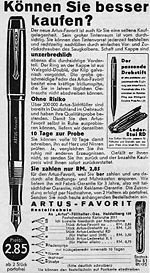Lamy
Although Lamy, being born in 1930, appears to be one of the historic German producers, is often seen as a recently founded company. But since the '60s its models have always been characterized by the attention to design and design research, with the production of great value models like the Lamy 2000 that, for their futuristic and minimalist style, have earned the company an image of modernity and avant-garde.
Having always invested in research and development, the company has been able to successfully overcome the crisis period following the ballpoint pen introduction, keeping up with the times and adapting to new market demands, on which it remained continuously present from the foundation. To date Lamy stands out as a manufacturer of midrange fountain pens, and writing tools for everyday use. Although the company has chosen not to produce luxury models, his fountaon pens are of excellent quality and maintain that particular attention to stylistic innovation that makes them always relevant and interesting.
| Lamy |
|---|
| Brand pages |
| Brand advertising |
| Brand photos |
| Instructions sheet |
| Other documents |
| Patents |
History
The Lamy was born at the hands of Joseph C. Lamy in 1930 in Heidelberg, under the name of Orthos Fullhalterfabrik C. J. Lamy. Joseph C. Lamy had been director of the exports of Parker until the 20's. In 1927 he returned to Heidelberg as Parker Germany' general manager in the period in which it had acquired the Osmia for the Duofold production in Germany.
At the end of 1929, more or less simultaneously with Osmia discharge by Parker , Joseph Lamy resigned to create his company. He moved to Berlin and began production of celluloid pens marked Orthos, very similar to Duofold (which at that time was much imitated) produced in two sizes and a wide range of colors.
In 1933 Lamy acquired a first patent for a pen/pencil combination, and put into production a large pen, always meant to compete with the Duofold. There is little information on these years, and specific models are not known, the pens were simply marketed under the brand Orthos.

Also Joseph C. Lamy could foresee the times sensing the potential of plastic, and acquired the Artus Fullaltergesellschaft Kaufmann und Co., whose origins seem to date back to 1936/37, beginning, first in Europe, to produce plastic injection pens. The first model was made with a new patented piston filler mechanism, still marketed under the Artus brand while stood out clearly from predecessors.
It is unclear whether the production of plastic pens began around 1939, approximate date of the acquisition of Artus, or only after the war. It is not clear even when it ceased to use the Orthos trademark, but at least until 1941 [1] the brands coexisted sharing address and phone number, even during a change of venue took place in 1940.
In subsequent years, the range was expanded with new models such as the Artus Rekord, Perfect, Favorit, Ballit, Schulüller, Prinz, Junior. The Artus concentrated in manufacturing economic and functional pens, with a focus on the student market; it also was capable to range over the whole field of the writing instruments. The company also stood out for the choice of a commercial diffusion based on direct sales by mail, bypassing the dealer network of stationery and supplies. In 1949 the Artus was renamed Artus, C. Josef Lamy, and the brand continued to exist until 1972.
Solo nel 1952 l'azienda immise sul mercato la prima penna marcata Lamy, il modello Lamy 27, con caricamento a stantuffo e pennino semi-coperto, di forme affusolate con uno stile che richiama quello della Parker 51, che in quel periodo vedeva innumerevoli imitatori. Nonostante la somiglianza, la Lamy 27 era una penna con una sua chiara personalità, e presentava notevoli innovazioni tecniche, ed in particolare il sistema di alimentazione, denominato Tintomatic, che viene usato ancora oggi per la sua caratteristica di garantire un flusso costante di inchiostro nonostante le variazioni di temperatura e pressione, grazie a dei micro intarsi intorno all'alimentatore.
Nel 1966 l'azienda creò quello che viene considerato il suo capolavoro, la Lamy 2000. Per la realizzazione di questa penna la Lamy si rivolse a Gerd A. Müller un famoso designer industriale che seguiva i dettami stilistici della Bauhaus, per cui la forma segue dalla funzione. La penna venne realizzata in Makrolon, una resina plastica di policarbonato rinforzata con fibre di vetro, un materiale per l'epoca rivoluzionario. Dotata di caricamento a stantuffo la penna viene considerata uno dei migliori esempi di design moderno per la semplicità delle linee e la funzionalità della realizzazione.
Negli anni successivi la Lamy ha sempre mantenuto una costante ricerca nello stile e nella realizzazione penne funzionali e robuste. Senza puntare alla ricerca dell'oggetto di lusso esclusivo (dal costo proibitivo), ma senza neanche scadere nella cultura dell'usa e getta al minimo costo (e valore) possibile, la Lamy è riuscita a restare sul mercato degli strumenti di scrittura proprio grazie alla sua capacità di creare penne di design moderno e di elevata qualità costruttiva, ed oggi risulta essere il principale produttore tedesco di articoli da scrittura.
Cronologia
| Anno | Avvenimento |
|---|---|
| 1930 | l'azienda viene fondata da Joseph C. Lamy a Heidelberg come Orthos Fullhalterfabrik C. J. Lamy |
| 1939 | l'azienda acquisisce la Artus Fullaltergesellschaft Kaufmann und Co (data incerta) |
| 1939 | l'azienda introduce le Favorit (data incerta) |
| 1952 | l'azienda introduce le Lamy 27 |
| 1966 | l'azienda introduce le Lamy 2000 |
| 1967 | l'azienda dismette le Artus Prinz |
Riferimenti esterni
- [1] Sito ufficiale dell'azienda
- [2] Sito dedicato alla storia della Lamy, inattivo
- [3] Articolo sulla Lamy
- [4] Articolo e discussione sulla Lamy 27
- [5] Articolo e discussione sulla Lamy 2000
- [6] Storia del design, dal sito dell'azienda
Note
- ↑ at least as reported in this discussion.
